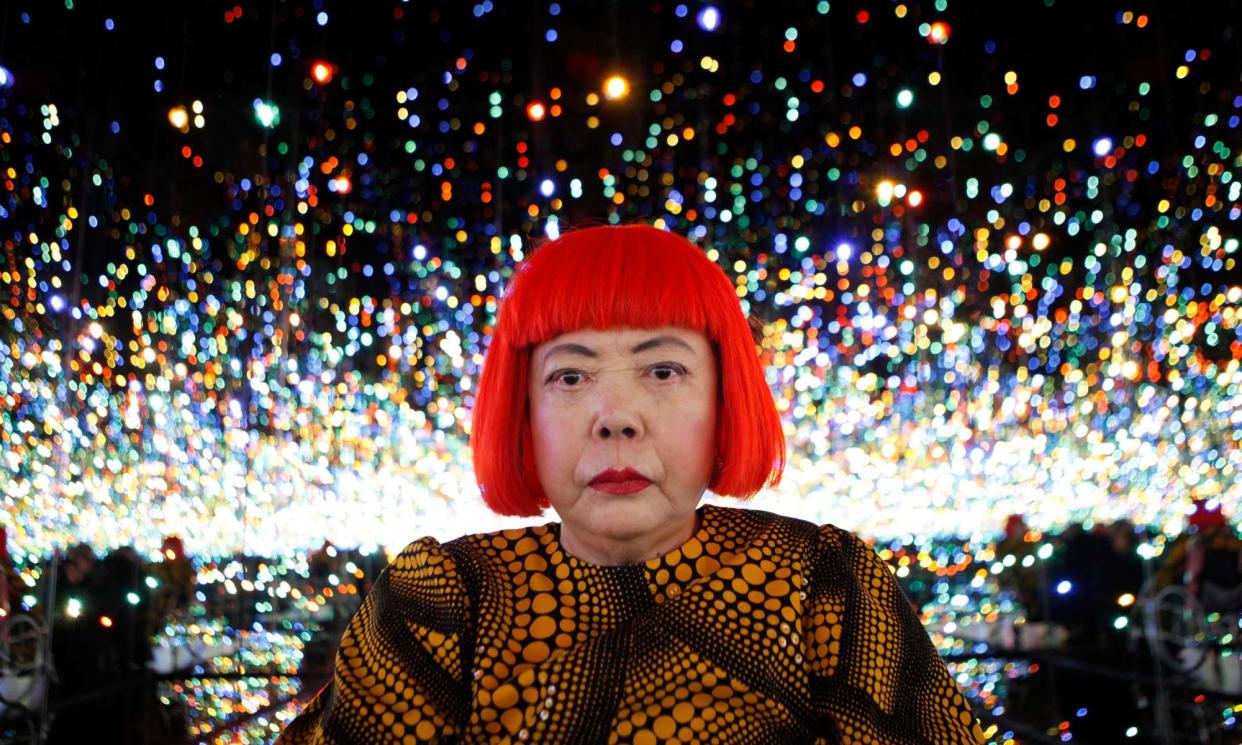Yayoi Kusama exhibition to bring art star’s infinity rooms and polka dots to NGV

Yayoi Kusama, the Japanese artist who has become an Instagram favourite in her 90s with her fantastical pumpkin sculptures, polka dots and kaleidoscopic infinity rooms, is the subject of a blockbuster retrospective heading to Australia.
Related: Yayoi Kusama: the world’s favourite artist?
In December, the National Gallery of Victoria will present one of its most expansive exhibitions to date, with eight decades of work by Kusama – now 95 years old – on display across the gallery’s entire ground floor.
The retrospective will spill out of the gallery’s interiors and on to the Federation Court, and will include an as yet unseen Kusama installation under the cascades of the building’s familiar water wall.
Among the 180 works on show will be at least one new “infinity mirror room”: a room of mirrors, polka dots and coloured lights that reflect for ever. It is these immersive kaleidoscopic works, representing Kusama’s lifelong exploration of self-obliteration and the infinity of space, that have earned her the title of world’s most Instagrammable artist.
With more than 20 mirror rooms in existence across the world, the Smithsonian’s Hirshhorn Museum in Washington DC made history in 2022 when it showed six of the rooms in the one exhibition. After seven months on display the museum was forced to extend the exhibition twice, such was the public demand.
The NGV isn’t stating definitively how many infinity rooms Melbourne will get yet, but the senior NGV curators Wayne Crothers and Miranda Wallace have suggested it will be more than six.
The exhibition will also give Australia its first glimpse of a newly acquired Dancing Pumpkin, one of three Kusama has recently created, the first being displayed in the New York Botanical Garden in 2021.
“It’s a very different pumpkin to the iconic pumpkin that everybody knows,” Crothers said.
“It’s a new version of the pumpkin … a huge piece which sort of lifts off the ground, almost five metres high, and about seven metres across. It’s almost like a huge sort of pavilion that you can walk around underneath.”
Kusama has been painting and sculpting pumpkins since she was a child, growing up on a plant nursery and seed farm in Hirohito’s militarised Japan. It is believed the Alice in Wonderland surrealism of her work developed at a young age after she began experiencing hallucinations. According to the 2018 documentary Kusama: Infinity, the artist used art to make sense of her mental turmoil and childhood abuse.
Her obsession with self-obliteration began to mature once she arrived in New York, creating her first infinity mirror room in 1965.
The following year she invited herself to the Venice Biennale and set up what she described as her “kinetic carpet” outside the host country’s pavilion. Her Narcissus Garden, consisting of hundreds of mirrored spheres, was sold off by the artist one ball at a time for US$2 each until biennale authorities put a stop to it.
In an exhibition that pays homage to all eight decades of Kusama’s paintings, sculptures, installations, writing and activism, the NGV exhibition will include a new iteration of Narcissus Garden that will involve 1,400 reflective silver balls.
Kusama was commenting on the commercialisation of art at the time, Wallace said, saying her take on Narcissus Garden for the NGV would be “a kind of new version … for the 21st century”.
Visitors would be asked to donate to enable the NGV to buy the work for its collection – a strategy the gallery used in 2018 that enabled it to acquire Salvador Dalí’s 1946 painting Trilogy of the desert: Mirage, costing in excess of $5m.
The nonagenarian artist will not be attending the opening of her Australian retrospective. Kusama has rarely travelled outside Japan since she voluntarily committed herself to a psychiatric facility outside Tokyo in the 1970s. She travels the short distance to her studio each day where she continues her art practice, which has been focused on painting since the early 2000s.
Works created in her childhood, and those created as recently as this year, will be included in the retrospective.
“The advantage of seeing this enormous longevity of practice is that you begin to understand how there are these connections between the works of the 1950s and 60s through to the present,” Wallace said.
“It’s an interesting journey to go on, which is why we’ve devoted the space to it. It’s an expansive story.”
Yayoi Kusama will open at the NGV on 15 December.


